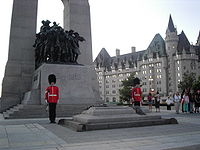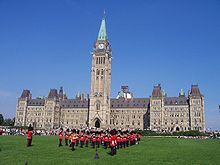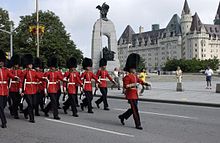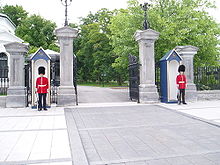- Ceremonial Guard
-
For ceremonial military units in general, see honor guard.
The Ceremonial Guard (CG) is an ad hoc military unit in the Canadian Forces with elements drawn principally from two Primary Reserve (militia) regiments of Foot Guards: The Governor General's Foot Guards from Ottawa and the Canadian Grenadier Guards from Montreal. Every summer, the Ceremonial Guard performs the Changing the Guard ceremony on Parliament Hill and posts sentries at Rideau Hall, the residence of the Governor General of Canada, and as of the summer of 2007, the National War Memorial.
As any guard unit in the Canadian Forces, uniforms originate from the Queen's Guard.
Contents
Unit composition
Collectively, the troops assembled from the two contributing regiments, as well as augmentees from other units throughout Land Force Central Area and the remainder of the Canadian Militia, form two companies of the Ceremonial Guard. 1 Company, CG comprises soldiers wearing the uniform and parading the colours of the Governor General's Foot Guards. 2 Company, CG has a similar composition, but wears the uniform and carries the colours of the Canadian Grenadier Guards. Each company includes two platoons of soldiers, each platoon divided into two 'divisions' of soldiers generally numbering between 20-25 rank and file plus leadership. The divisions are further subdivided into two sections for administrative purposes, however all daily activities are carried out at at least the division level. The nomenclature of 'division' for such a small formed body of troops is unique to the Ceremonial Guard.
The Ceremonial Guard maintains no Regimental Colour nor has any battle honours of its own as it is not a permanent unit in the Canadian Forces' order of battle. The only colours flown in the ceremonies are those of the two regiments involved.
The Ceremonial Guard also maintains its own regimental band and pipers that form a separate company, as well as a fourth company for administration and support personnel. Musicians are drawn from military units and colleges or universities from across Canada and applicants must first pass an audition to be considered. The band of the ceremonial guard is widely regarded as a superb musical organization, hence the national level application process.
The unit exists with a full composition only from early June to the end of August. During the rest of the year a small administrative corps remains to prepare for next year's public duties season, and beginning in early May the unit will stand up partially to allow for the conduct of Basic Military Qualification and Primary Leadership Qualification courses.
Public duties
The primary and most visible function of the Ceremonial Guard is, as mentioned, the Changing the Guard on Parliament Hill in Ottawa, Ontario, the national capital of Canada. The Changing the Guard Ceremony is a parade representing the changing of the guards posted at Rideau Hall, the official residence of the Canadian monarch when in Ottawa, and her representative, the Governor General, in her absence. A full company of two platoons is employed in daily public duties, with both divisions of one platoon parading as the 'new guard' - those to take over duties at Rideau Hall - and the other platoon of the company split, one division parading as 'old guard', and the other performing sentry duties at Rideau Hall for the day.
Changing the Guard
The parade begins at the Cartier Square Drill Hall with the Drum Major, followed by the band, an officer carrying the Regimental Colours, the old guard, and finally the two divisions of the 'new guard'. Turning North onto Queen Elizabeth Dr., the parade continues underneath the Laurier Ave. bridge and then turns left onto the ramp leading onto Laurier Avenue (Ottawa). The parade then continues with a right turn onto Elgin St, then 'wheels' onto Wellington before the parade arrives on Parliament Hill precisely at 10:00AM.
The parade marches onto the east lawn of Parliament, with the band centered at the northernmost edge of the lawn and facing south. The old guard marches to the west side of the east lawn and faces the east block, while the new guard marches to the east side of the lawn and faces west towards the old guard. After the old and new guards are formed from three ranks into two, and independently dressed off for proper alignment the two sergeants of the guard - commanders of the two divisions of new guard - advance to be inspected by the company sergeant-major. Following inspection, the number two division sergeant marches to his position while the number one division sergeant stands still. The new guard is then given the order "Get on parade", at which point they advance to the tune of "The British Grenadiers" from the band, and form up dressed off the sergeants of the guard. The new guard's persons and weapons are inspected by the company commander, and they are stood at ease.
Following the inspection of the new guard, the old guard is inspected. After this inspection, the sergeants of the guard and division seconds in command are ordered to 'take post'- the sergeant of the guard marches from the right flank to directly behind the guard, while the second in command marches from the left flank to the right. The parade is then called to the present arms for the marching on of the regimental colours. With the colours marched on, the new guard advances at the slow march, ceremonially 'taking up the ground' from the old guard. The old guard and new guard salute each other at present arms, and the national anthem O Canada is played. Following this, the old guard commander presents the ceremonial key to Rideau Hall to the new guard commander. The parade is then formed into three ranks and marched off at the slow march, transitioning into the quick march. The order of march differs only in that the old guard is now at the rear, instead of between the band and new guard.
Sentry duty
The other highly visible public duty of the Ceremonial Guard is sentry duty at Rideau Hall. The sentries are ceremonial in nature only and do not generally perform actual guard duty, however all are trained military personnel and procedures and orders do exist for the Ceremonial Guard to adopt an armed night guard of Rideau Hall should sufficient security threat arise.
The sentries are posted daily from 9:00AM EST to 5:00PM EST, every hour on the hour. At 9:00 AM the posting corporal - generally a corporal from the junior leadership but sometimes a corporal from the ranks - marches out accompanied by the four sentries, two escorts, and a bagpiper. The corporal, sentries, and escorts are all dressed in full scarlet uniforms and carry rifles with bayonets fixed. The party marches to the Sussex Drive gate of Rideau Hall where the first two sentries are posted and have their duties read to them. The party then marches back to Rideau Hall itself where the two remaining sentries are posted and have their duties read.
 Two ceremonial guards at the Canadian War Memorial in Ottawa.
Two ceremonial guards at the Canadian War Memorial in Ottawa.
Throughout the day Rideau Hall will be visited by the Officer Commanding of the parade and the Company Sergeant-Major. They will generally elect to observe a relief of the sentries, and sometimes the officer commanding will take a report from the sentries on duty. The guard sergeant for Rideau Hall may also elect to do rounds to check on both of the sentry posts.
Drill Team
Beginning in 2006, Ceremonial Guard took members of the parade company to form a silent drill team. Their first and only show was during Fortissimo. The next year followed the same format as the previous. In 2008 the Drill Team's duties were expanded and they went to Halifax to perform in the Royal Nova Scotia International Tattoo, along with other performances in Kingston and Ottawa. In 2009 the Drill Team was removed from the parade company and therefore no longer took part in the Changing the Guard on Parliament Hill. This Drill Team performed in Washington, D.C., Toronto, Ottawa and again in Halifax for the International Tattoo.
Recruiting
Traditionally, Ceremonial Guard has been a powerful recruiting force for the contributing regiments, particularly the Governor General's Foot Guards. Recruiting for the Ceremonial Guard is done by each of the contributing units. All recruits are enrolled as primary reservists in the Canadian Forces, a part time military commitment. All Guardsmen however are trained soldiers, and many have already deployed operationally, whether in the former Yugoslavia, in Afghanistan, or elsewhere.
Extra functions
In addition to the Changing the Guard, the Ceremonial Guard takes part in many other functions, such as the annual Governor General's inspection in late June, the Canada Day celebration on 1 July, the "Fortissimo" Sunset Ceremony that takes place in mid-late August on Parliament Hill, and the annual Trooping the Colour. It also participates in military funerals (for example, Jack Layton's procession at Parliament), important visits (Queen Elizabeth II in 2010, Royal Couple in 2011). The band of the Ceremonial Guard has many engagements outside of public duties, including featuring prominently in the annual Nova Scotia International Tattoo.
External links
Categories:- Guards regiments
- Canadian ceremonial units
Wikimedia Foundation. 2010.



